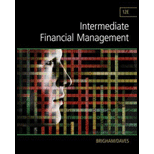
a)
To determine: The definition of Baumol model.
a)
Explanation of Solution
The Baumol show could be a demonstration for building up the firm's target cash adjust that closely takes after the EOQ show utilized for stock. The demonstrate accept (1) that the firm employs cash at a relentless, unsurprising rate, (2) that the firm's
b)
To determine: The definition of total carrying cost, total ordering cost, and total inventory cost.
b)
Explanation of Solution
Carrying costs are the expense of carrying stock. Ordering costs are the costs of requesting stock. Total inventory costs are the entirety of ordering and carrying costs.
c)
To determine: The definition of EOQ, EOQ model, and EOQ range.
c)
Explanation of Solution
The Economic Ordering Quantity (EOQ) is the arrange amount that minimizes the costs of requesting and carrying inventories. The EOQ model is the condition utilized to discover the EOQ. The range around the ideal requesting amount which will be requested without essentially influencing add up to stock costs is the EOQ range.
d)
To determine: The definition of reorder point and safety stock.
d)
Explanation of Solution
The reorder point is the stock level at which a unused arrange is put. Safety stock is stock held to watch against larger-than-normal deals and/or shipping delays.
e)
To determine: The definition of red-line method, two-bin method, computerized inventory control system.
e)
Explanation of Solution
The red line strategy could be a strategy for stock control, as is the two-bin strategy. Computerized inventory
f)
To determine: The definition of just-in-time system and outsourcing.
f)
Explanation of Solution
JIT frameworks allude to getting inventories fair as they are required. Firms that utilize such frameworks are endeavoring to play down stock carrying costs. Out-sourcing is the practice of obtaining components instead of making them in-house.
Want to see more full solutions like this?
Chapter 23 Solutions
Intermediate Financial Management (MindTap Course List)
- No ai tool What is the role of an underwriter in an IPO?A) To lend money to the companyB) To set the dividend policyC) To buy the securities and sell them to the publicD) To manage the company’s operationsarrow_forwardWhich of the following is a money market instrument?A) Treasury bondsB) Corporate bondsC) Commercial paperD) Common stock need help!!arrow_forwardFinance Subject.Which of the following is a money market instrument?A) Treasury bondsB) Corporate bondsC) Commercial paperD) Common stockarrow_forward
- Help please without use of AI. no What is the main purpose of financial ratios?A) To guarantee a company's profitabilityB) To evaluate a company's financial performance and healthC) To increase a company's stock priceD) To ensure a company's debts are eliminatedarrow_forwardPlease don't use ai tool If a stock’s beta is 1.5, what does this indicate?A) The stock is less volatile than the marketB) The stock is more volatile than the marketC) The stock is not correlated with the market D) The stock is risk-freearrow_forwardNo ai What is the primary function of a financial market?A) To set interest ratesB) To facilitate the transfer of funds between savers and borrowersC) To regulate the banking industryD) To manage the government’s budgetarrow_forward
- no What is the main purpose of financial ratios?A) To guarantee a company's profitabilityB) To evaluate a company's financial performance and healthC) To increase a company's stock priceD) To ensure a company's debts are eliminatedarrow_forwardplease don't use chatgpt What happens to the value of money when inflation increases?A) The value of money increasesB) The value of money decreasesC) The value of money remains unchangedD) The value of money fluctuates randomly helparrow_forwardDo not use Ai tool What happens to the value of money when inflation increases?A) The value of money increasesB) The value of money decreasesC) The value of money remains unchangedD) The value of money fluctuates randomlyarrow_forward
- No AI tool. Which of the following best defines a bond's coupon rate?A) The market rate of interest on the bondB) The annual interest payment as a percentage of the bond's face valueC) The difference between the bond's face value and its market priceD) The total return from holding the bond to maturityarrow_forwardNo ai!! answer it A portfolio's risk can be reduced by: A) Investing in a single stock B) Diversifying investments across different asset classes C) Borrowing money to invest more D) Only investing in high-risk assets need help.arrow_forwardNo chatgpt! A portfolio's risk can be reduced by: A) Investing in a single stock B) Diversifying investments across different asset classes C) Borrowing money to invest more D) Only investing in high-risk assets need help!arrow_forward
 Intermediate Financial Management (MindTap Course...FinanceISBN:9781337395083Author:Eugene F. Brigham, Phillip R. DavesPublisher:Cengage Learning
Intermediate Financial Management (MindTap Course...FinanceISBN:9781337395083Author:Eugene F. Brigham, Phillip R. DavesPublisher:Cengage Learning Cornerstones of Cost Management (Cornerstones Ser...AccountingISBN:9781305970663Author:Don R. Hansen, Maryanne M. MowenPublisher:Cengage Learning
Cornerstones of Cost Management (Cornerstones Ser...AccountingISBN:9781305970663Author:Don R. Hansen, Maryanne M. MowenPublisher:Cengage Learning EBK CONTEMPORARY FINANCIAL MANAGEMENTFinanceISBN:9781337514835Author:MOYERPublisher:CENGAGE LEARNING - CONSIGNMENT
EBK CONTEMPORARY FINANCIAL MANAGEMENTFinanceISBN:9781337514835Author:MOYERPublisher:CENGAGE LEARNING - CONSIGNMENT- Principles of Accounting Volume 1AccountingISBN:9781947172685Author:OpenStaxPublisher:OpenStax College
 Principles of Cost AccountingAccountingISBN:9781305087408Author:Edward J. Vanderbeck, Maria R. MitchellPublisher:Cengage Learning
Principles of Cost AccountingAccountingISBN:9781305087408Author:Edward J. Vanderbeck, Maria R. MitchellPublisher:Cengage Learning





